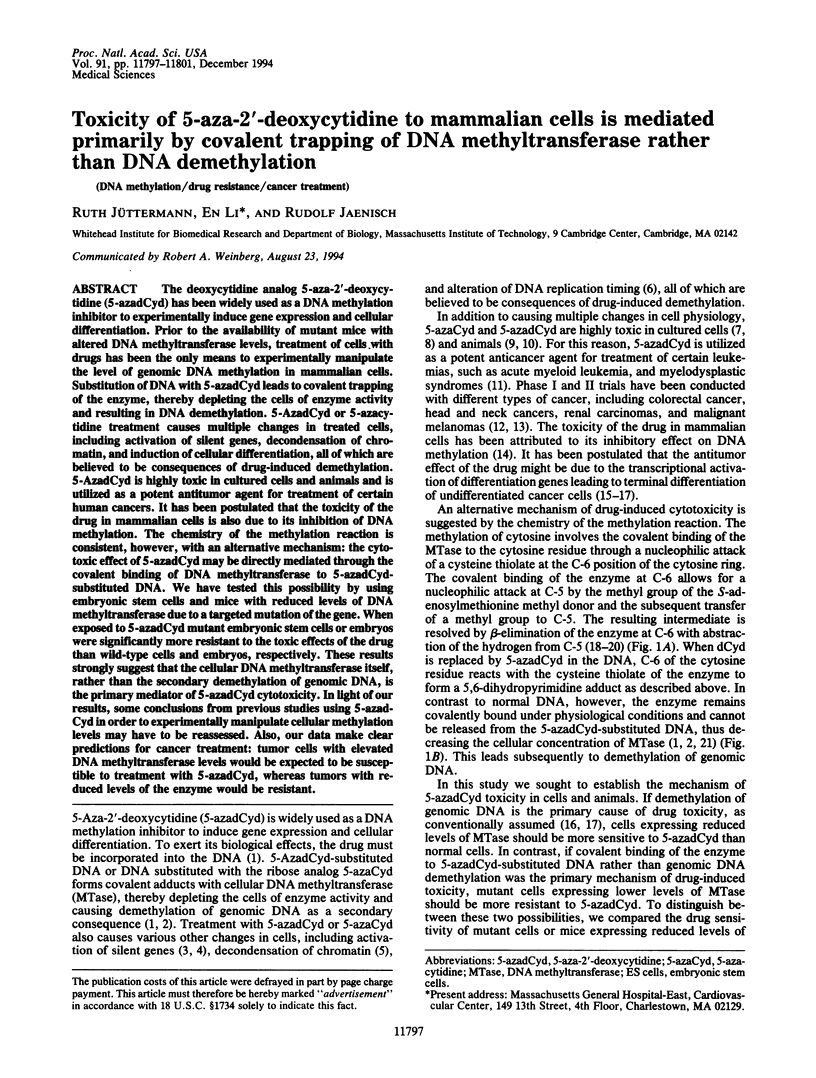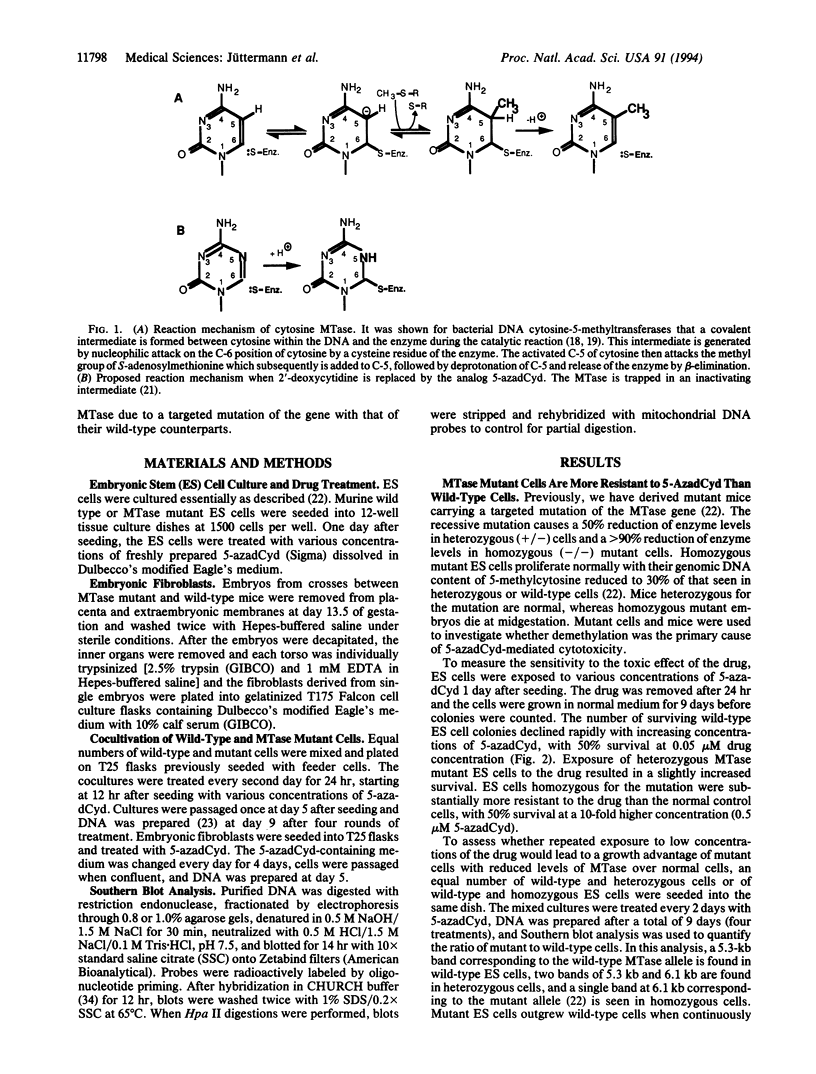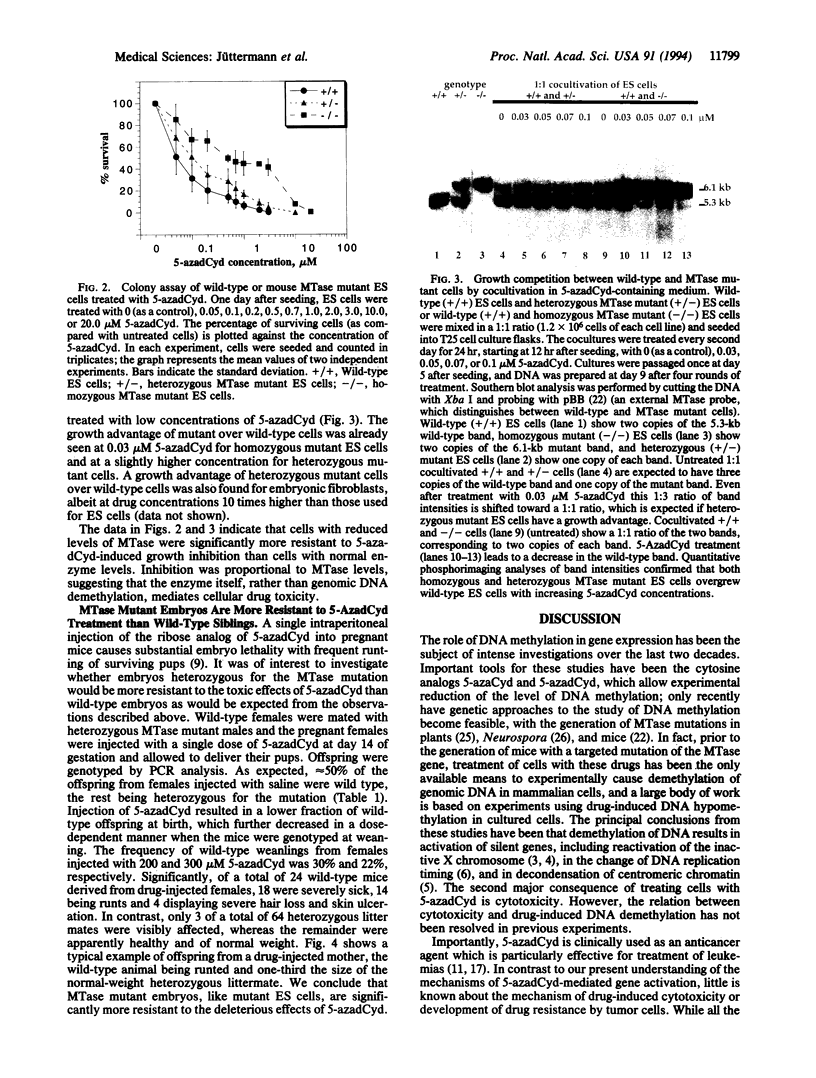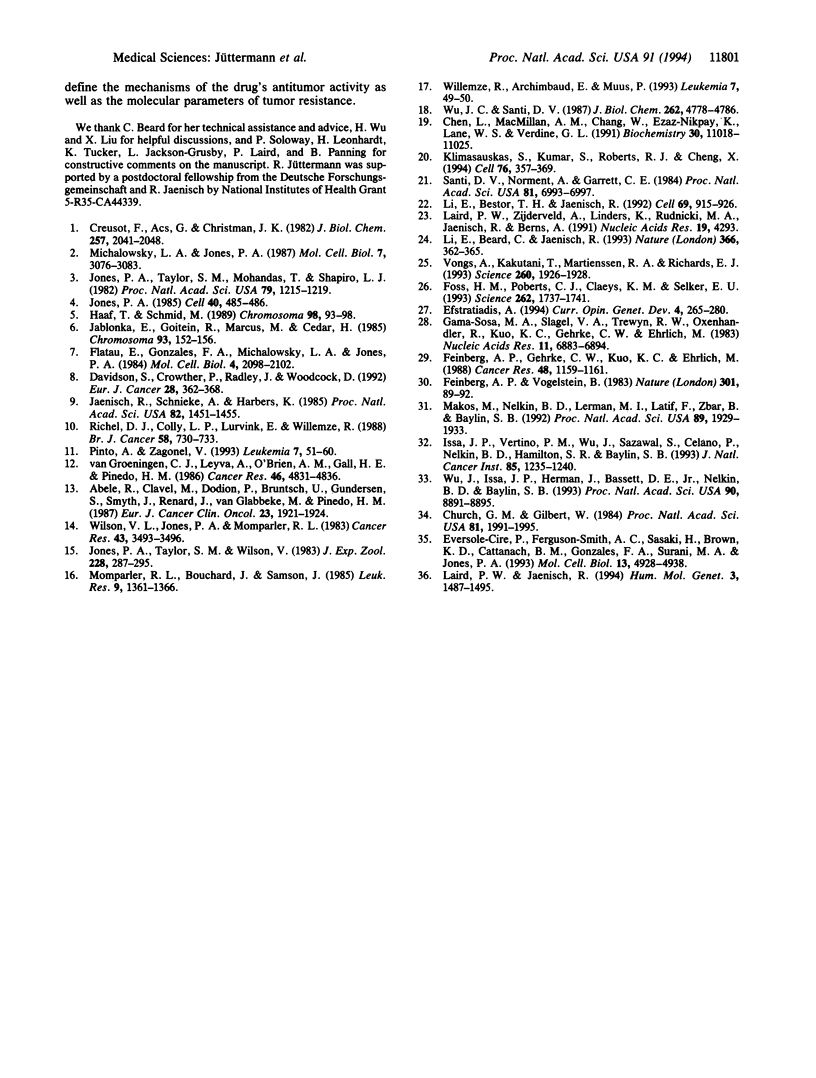Abstract
The deoxycytidine analog 5-aza-2'-deoxycytidine (5-azadCyd) has been widely used as a DNA methylation inhibitor to experimentally induce gene expression and cellular differentiation. Prior to the availability of mutant mice with altered DNA methyltransferase levels, treatment of cells with drugs has been the only means to experimentally manipulate the level of genomic DNA methylation in mammalian cells. Substitution of DNA with 5-azadCyd leads to covalent trapping of the enzyme, thereby depleting the cells of enzyme activity and resulting in DNA demethylation. 5-AzadCyd or 5-azacytidine treatment causes multiple changes in treated cells, including activation of silent genes, decondensation of chromatin, and induction of cellular differentiation, all of which are believed to be consequences of drug-induced demethylation. 5-AzadCyd is highly toxic in cultured cells and animals and is utilized as a potent antitumor agent for treatment of certain human cancers. It has been postulated that the toxicity of the drug in mammalian cells is also due to its inhibition of DNA methylation. The chemistry of the methylation reaction is consistent, however, with an alternative mechanism: the cytotoxic effect of 5-azadCyd may be directly mediated through the covalent binding of DNA methyltransferase to 5-azadCyd-substituted DNA. We have tested this possibility by using embryonic stem cells and mice with reduced levels of DNA methyltransferase due to a targeted mutation of the gene. When exposed to 5-azadCyd mutant embryonic stem cells or embryos were significantly more resistant to the toxic effects of the drug than wild-type cells and embryos, respectively. These results strongly suggest that the cellular DNA methyltransferase itself, rather than the secondary demethylation of genomic DNA, is the primary mediator of 5-azadCyd cytotoxicity. In light of our results, some conclusions from previous studies using 5-azadCyd in order to experimentally manipulate cellular methylation levels may have to be reassessed. Also, our data make clear predictions for cancer treatment: tumor cells with elevated DNA methyltransferase levels would be expected to be susceptible to treatment with 5-azadCyd, whereas tumors with reduced levels of the enzyme would be resistant.
Full text
PDF




Images in this article
Selected References
These references are in PubMed. This may not be the complete list of references from this article.
- Abele R., Clavel M., Dodion P., Bruntsch U., Gundersen S., Smyth J., Renard J., van Glabbeke M., Pinedo H. M. The EORTC Early Clinical Trials Cooperative Group experience with 5-aza-2'-deoxycytidine (NSC 127716) in patients with colo-rectal, head and neck, renal carcinomas and malignant melanomas. Eur J Cancer Clin Oncol. 1987 Dec;23(12):1921–1924. doi: 10.1016/0277-5379(87)90060-5. [DOI] [PubMed] [Google Scholar]
- Chen L., MacMillan A. M., Chang W., Ezaz-Nikpay K., Lane W. S., Verdine G. L. Direct identification of the active-site nucleophile in a DNA (cytosine-5)-methyltransferase. Biochemistry. 1991 Nov 19;30(46):11018–11025. doi: 10.1021/bi00110a002. [DOI] [PubMed] [Google Scholar]
- Church G. M., Gilbert W. Genomic sequencing. Proc Natl Acad Sci U S A. 1984 Apr;81(7):1991–1995. doi: 10.1073/pnas.81.7.1991. [DOI] [PMC free article] [PubMed] [Google Scholar]
- Creusot F., Acs G., Christman J. K. Inhibition of DNA methyltransferase and induction of Friend erythroleukemia cell differentiation by 5-azacytidine and 5-aza-2'-deoxycytidine. J Biol Chem. 1982 Feb 25;257(4):2041–2048. [PubMed] [Google Scholar]
- Davidson S., Crowther P., Radley J., Woodcock D. Cytotoxicity of 5-aza-2'-deoxycytidine in a mammalian cell system. Eur J Cancer. 1992;28(2-3):362–368. doi: 10.1016/s0959-8049(05)80054-1. [DOI] [PubMed] [Google Scholar]
- Efstratiadis A. Parental imprinting of autosomal mammalian genes. Curr Opin Genet Dev. 1994 Apr;4(2):265–280. doi: 10.1016/s0959-437x(05)80054-1. [DOI] [PubMed] [Google Scholar]
- Eversole-Cire P., Ferguson-Smith A. C., Sasaki H., Brown K. D., Cattanach B. M., Gonzales F. A., Surani M. A., Jones P. A. Activation of an imprinted Igf 2 gene in mouse somatic cell cultures. Mol Cell Biol. 1993 Aug;13(8):4928–4938. doi: 10.1128/mcb.13.8.4928. [DOI] [PMC free article] [PubMed] [Google Scholar]
- Feinberg A. P., Gehrke C. W., Kuo K. C., Ehrlich M. Reduced genomic 5-methylcytosine content in human colonic neoplasia. Cancer Res. 1988 Mar 1;48(5):1159–1161. [PubMed] [Google Scholar]
- Feinberg A. P., Vogelstein B. Hypomethylation distinguishes genes of some human cancers from their normal counterparts. Nature. 1983 Jan 6;301(5895):89–92. doi: 10.1038/301089a0. [DOI] [PubMed] [Google Scholar]
- Flatau E., Gonzales F. A., Michalowsky L. A., Jones P. A. DNA methylation in 5-aza-2'-deoxycytidine-resistant variants of C3H 10T1/2 C18 cells. Mol Cell Biol. 1984 Oct;4(10):2098–2102. doi: 10.1128/mcb.4.10.2098. [DOI] [PMC free article] [PubMed] [Google Scholar]
- Foss H. M., Roberts C. J., Claeys K. M., Selker E. U. Abnormal chromosome behavior in Neurospora mutants defective in DNA methylation. Science. 1993 Dec 10;262(5140):1737–1741. doi: 10.1126/science.7505062. [DOI] [PubMed] [Google Scholar]
- Gama-Sosa M. A., Slagel V. A., Trewyn R. W., Oxenhandler R., Kuo K. C., Gehrke C. W., Ehrlich M. The 5-methylcytosine content of DNA from human tumors. Nucleic Acids Res. 1983 Oct 11;11(19):6883–6894. doi: 10.1093/nar/11.19.6883. [DOI] [PMC free article] [PubMed] [Google Scholar]
- Haaf T., Schmid M. 5-Azadeoxycytidine induced undercondensation in the giant X chromosomes of Microtus agrestis. Chromosoma. 1989 Aug;98(2):93–98. doi: 10.1007/BF00291043. [DOI] [PubMed] [Google Scholar]
- Issa J. P., Vertino P. M., Wu J., Sazawal S., Celano P., Nelkin B. D., Hamilton S. R., Baylin S. B. Increased cytosine DNA-methyltransferase activity during colon cancer progression. J Natl Cancer Inst. 1993 Aug 4;85(15):1235–1240. doi: 10.1093/jnci/85.15.1235. [DOI] [PubMed] [Google Scholar]
- Jablonka E., Goitein R., Marcus M., Cedar H. DNA hypomethylation causes an increase in DNase-I sensitivity and an advance in the time of replication of the entire inactive X chromosome. Chromosoma. 1985;93(2):152–156. doi: 10.1007/BF00293162. [DOI] [PubMed] [Google Scholar]
- Jaenisch R., Schnieke A., Harbers K. Treatment of mice with 5-azacytidine efficiently activates silent retroviral genomes in different tissues. Proc Natl Acad Sci U S A. 1985 Mar;82(5):1451–1455. doi: 10.1073/pnas.82.5.1451. [DOI] [PMC free article] [PubMed] [Google Scholar]
- Jones P. A. Altering gene expression with 5-azacytidine. Cell. 1985 Mar;40(3):485–486. doi: 10.1016/0092-8674(85)90192-8. [DOI] [PubMed] [Google Scholar]
- Jones P. A., Taylor S. M., Mohandas T., Shapiro L. J. Cell cycle-specific reactivation of an inactive X-chromosome locus by 5-azadeoxycytidine. Proc Natl Acad Sci U S A. 1982 Feb;79(4):1215–1219. doi: 10.1073/pnas.79.4.1215. [DOI] [PMC free article] [PubMed] [Google Scholar]
- Jones P. A., Taylor S. M., Wilson V. DNA modification, differentiation, and transformation. J Exp Zool. 1983 Nov;228(2):287–295. doi: 10.1002/jez.1402280212. [DOI] [PubMed] [Google Scholar]
- Klimasauskas S., Kumar S., Roberts R. J., Cheng X. HhaI methyltransferase flips its target base out of the DNA helix. Cell. 1994 Jan 28;76(2):357–369. doi: 10.1016/0092-8674(94)90342-5. [DOI] [PubMed] [Google Scholar]
- Laird P. W., Jaenisch R. DNA methylation and cancer. Hum Mol Genet. 1994;3(Spec No):1487–1495. doi: 10.1093/hmg/3.suppl_1.1487. [DOI] [PubMed] [Google Scholar]
- Laird P. W., Zijderveld A., Linders K., Rudnicki M. A., Jaenisch R., Berns A. Simplified mammalian DNA isolation procedure. Nucleic Acids Res. 1991 Aug 11;19(15):4293–4293. doi: 10.1093/nar/19.15.4293. [DOI] [PMC free article] [PubMed] [Google Scholar]
- Li E., Beard C., Jaenisch R. Role for DNA methylation in genomic imprinting. Nature. 1993 Nov 25;366(6453):362–365. doi: 10.1038/366362a0. [DOI] [PubMed] [Google Scholar]
- Li E., Bestor T. H., Jaenisch R. Targeted mutation of the DNA methyltransferase gene results in embryonic lethality. Cell. 1992 Jun 12;69(6):915–926. doi: 10.1016/0092-8674(92)90611-f. [DOI] [PubMed] [Google Scholar]
- Makos M., Nelkin B. D., Lerman M. I., Latif F., Zbar B., Baylin S. B. Distinct hypermethylation patterns occur at altered chromosome loci in human lung and colon cancer. Proc Natl Acad Sci U S A. 1992 Mar 1;89(5):1929–1933. doi: 10.1073/pnas.89.5.1929. [DOI] [PMC free article] [PubMed] [Google Scholar]
- Michalowsky L. A., Jones P. A. Differential nuclear protein binding to 5-azacytosine-containing DNA as a potential mechanism for 5-aza-2'-deoxycytidine resistance. Mol Cell Biol. 1987 Sep;7(9):3076–3083. doi: 10.1128/mcb.7.9.3076. [DOI] [PMC free article] [PubMed] [Google Scholar]
- Momparler R. L., Bouchard J., Samson J. Induction of differentiation and inhibition of DNA methylation in HL-60 myeloid leukemic cells by 5-AZA-2'-deoxycytidine. Leuk Res. 1985;9(11):1361–1366. doi: 10.1016/0145-2126(85)90123-7. [DOI] [PubMed] [Google Scholar]
- Pinto A., Zagonel V. 5-Aza-2'-deoxycytidine (Decitabine) and 5-azacytidine in the treatment of acute myeloid leukemias and myelodysplastic syndromes: past, present and future trends. Leukemia. 1993 May;7 (Suppl 1):51–60. [PubMed] [Google Scholar]
- Richel D. J., Colly L. P., Lurvink E., Willemze R. Comparison of the antileukaemic activity of 5 aza-2-deoxycytidine and arabinofuranosyl-cytosine in rats with myelocytic leukaemia. Br J Cancer. 1988 Dec;58(6):730–733. doi: 10.1038/bjc.1988.298. [DOI] [PMC free article] [PubMed] [Google Scholar]
- Santi D. V., Norment A., Garrett C. E. Covalent bond formation between a DNA-cytosine methyltransferase and DNA containing 5-azacytosine. Proc Natl Acad Sci U S A. 1984 Nov;81(22):6993–6997. doi: 10.1073/pnas.81.22.6993. [DOI] [PMC free article] [PubMed] [Google Scholar]
- Vongs A., Kakutani T., Martienssen R. A., Richards E. J. Arabidopsis thaliana DNA methylation mutants. Science. 1993 Jun 25;260(5116):1926–1928. doi: 10.1126/science.8316832. [DOI] [PubMed] [Google Scholar]
- Willemze R., Archimbaud E., Muus P. Preliminary results with 5-aza-2'-deoxycytidine (DAC)-containing chemotherapy in patients with relapsed or refractory acute leukemia. The EORTC Leukemia Cooperative Group. Leukemia. 1993 May;7 (Suppl 1):49–50. [PubMed] [Google Scholar]
- Wilson V. L., Jones P. A., Momparler R. L. Inhibition of DNA methylation in L1210 leukemic cells by 5-aza-2'-deoxycytidine as a possible mechanism of chemotherapeutic action. Cancer Res. 1983 Aug;43(8):3493–3496. [PubMed] [Google Scholar]
- Wu J. C., Santi D. V. Kinetic and catalytic mechanism of HhaI methyltransferase. J Biol Chem. 1987 Apr 5;262(10):4778–4786. [PubMed] [Google Scholar]
- Wu J., Issa J. P., Herman J., Bassett D. E., Jr, Nelkin B. D., Baylin S. B. Expression of an exogenous eukaryotic DNA methyltransferase gene induces transformation of NIH 3T3 cells. Proc Natl Acad Sci U S A. 1993 Oct 1;90(19):8891–8895. doi: 10.1073/pnas.90.19.8891. [DOI] [PMC free article] [PubMed] [Google Scholar]
- van Groeningen C. J., Leyva A., O'Brien A. M., Gall H. E., Pinedo H. M. Phase I and pharmacokinetic study of 5-aza-2'-deoxycytidine (NSC 127716) in cancer patients. Cancer Res. 1986 Sep;46(9):4831–4836. [PubMed] [Google Scholar]




